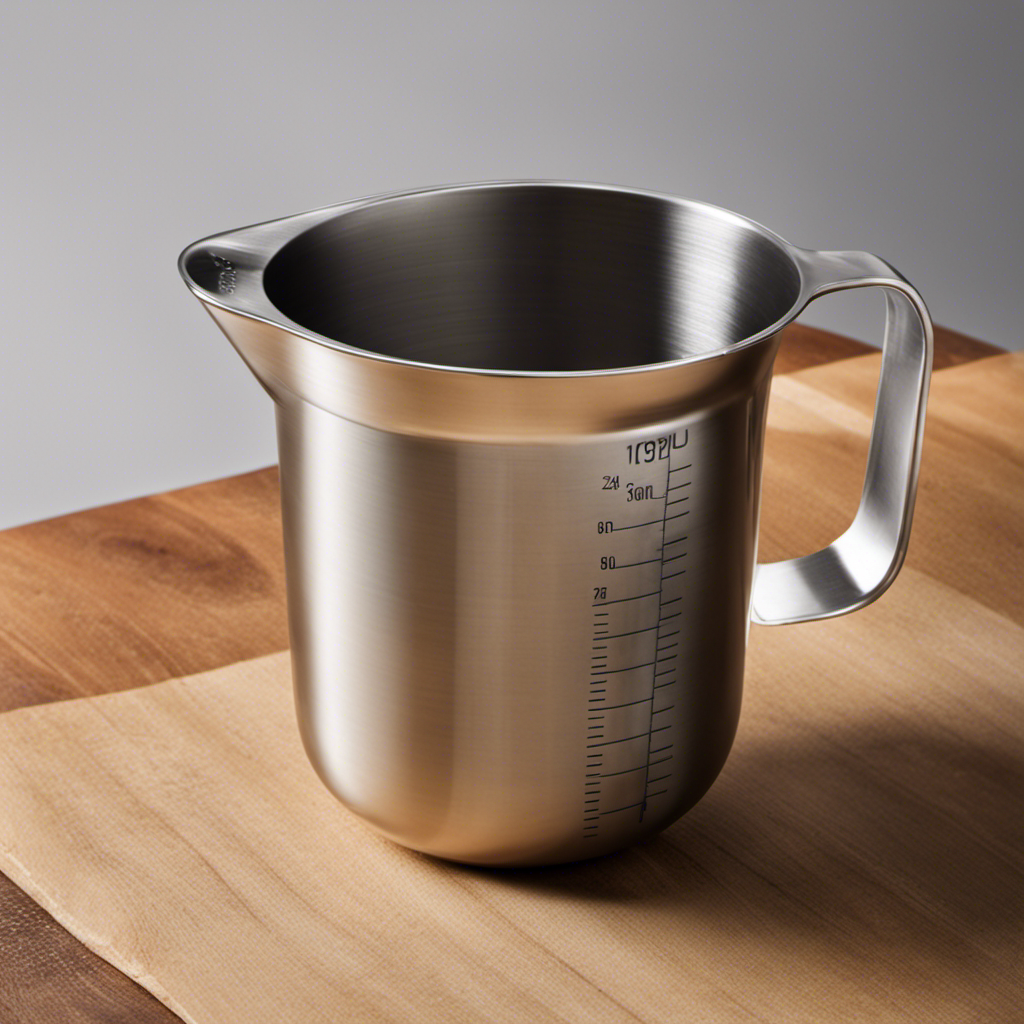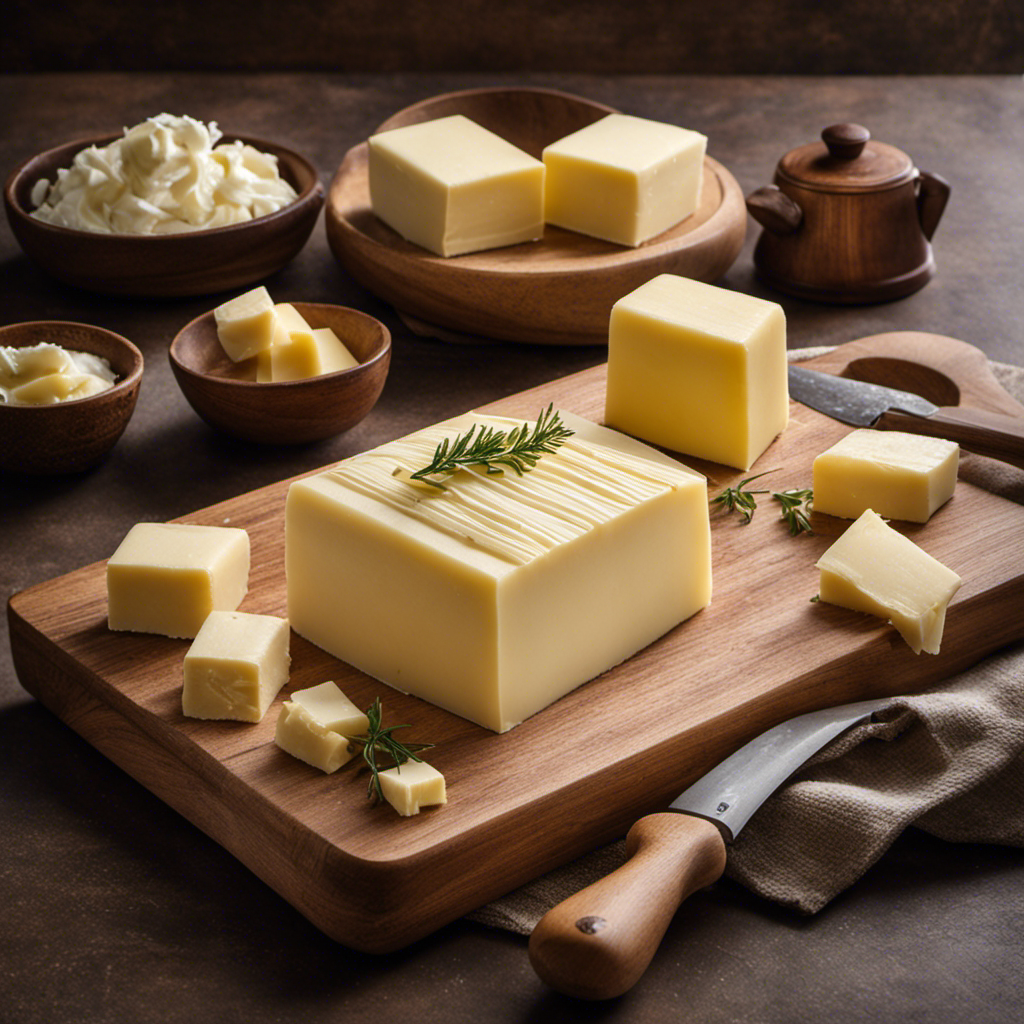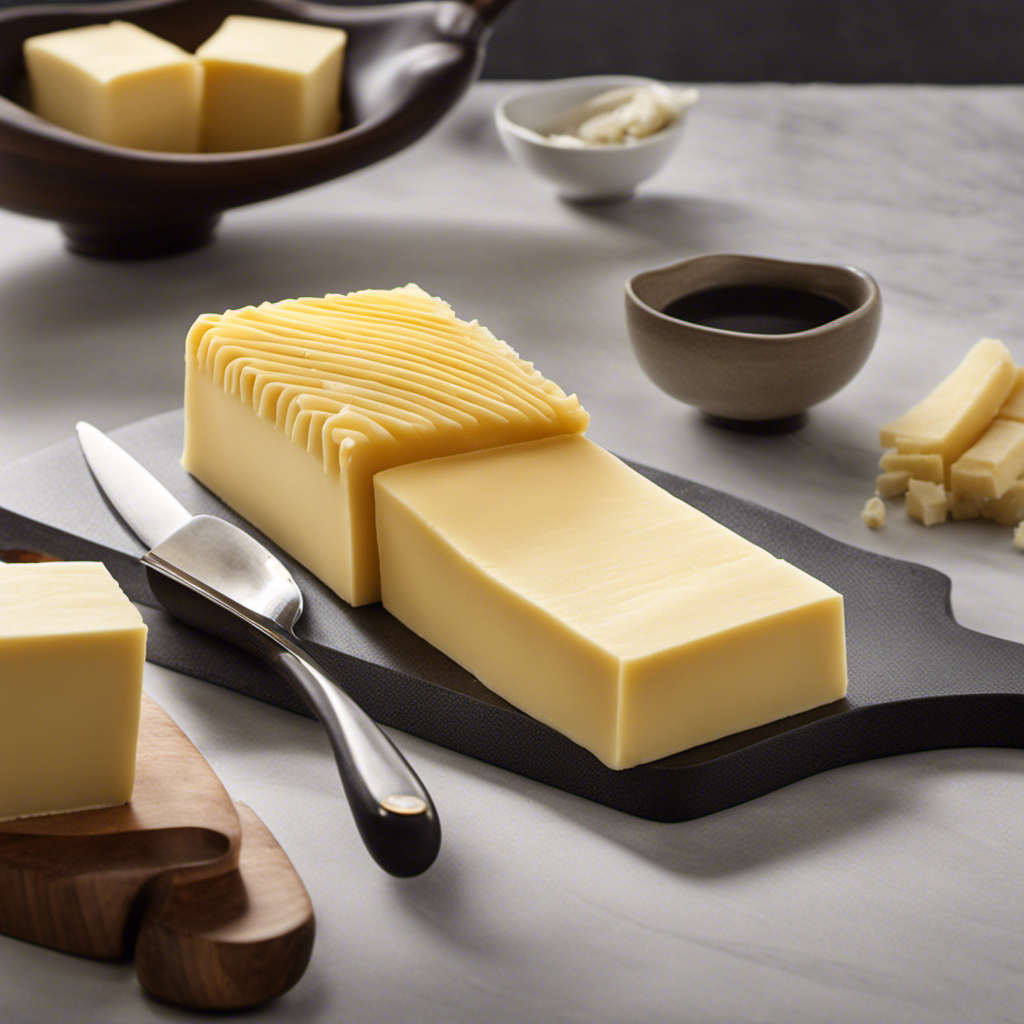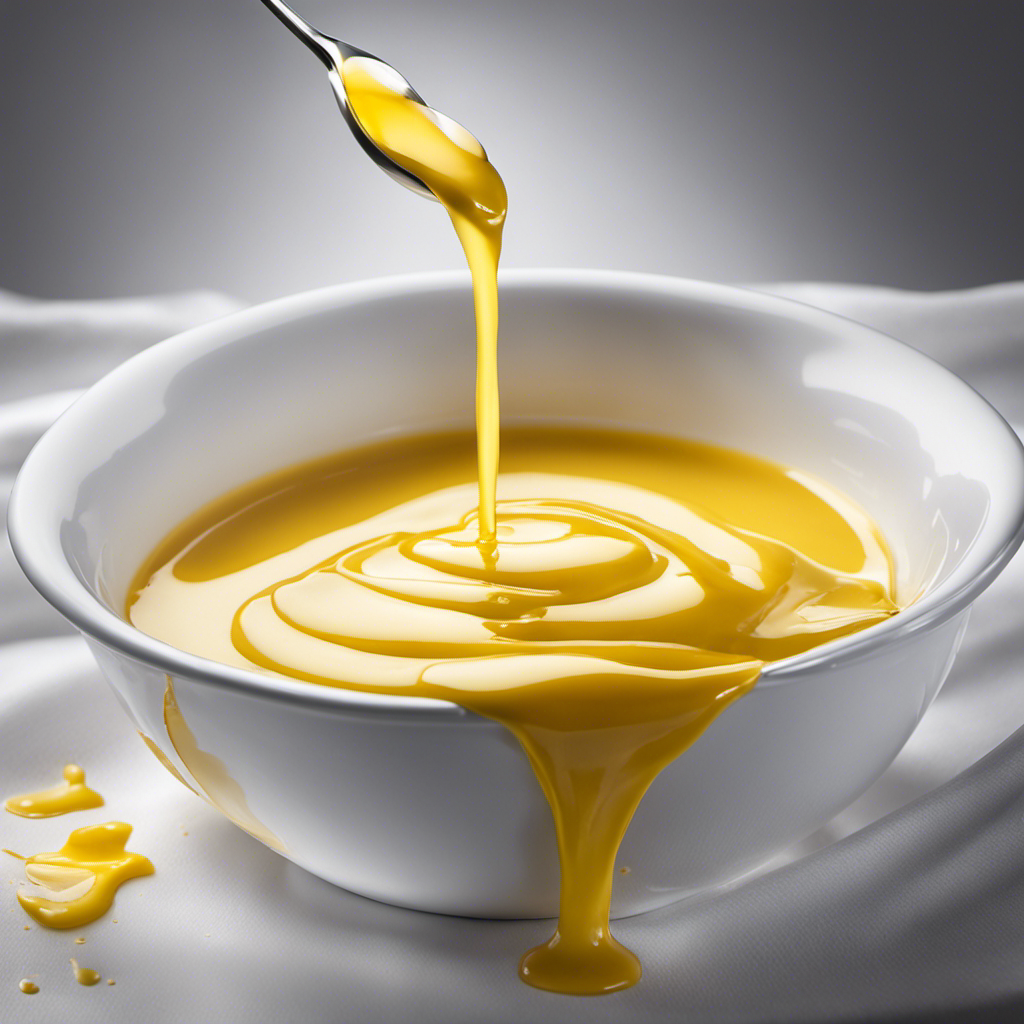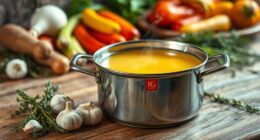I’ve always been curious about the exact number of tablespoons contained in 2/3 cup of butter. It’s a frequent query in the world of baking, where precise measurements are key to nailing the ideal texture and flavor.
In this article, we’ll dive into the basics of butter measurement, explore different conversion systems, and provide expert advice on how to convert butter measurements like a pro.
So if you’re ready to elevate your baking game, let’s find out exactly how many tablespoons are in 2/3 cup of butter.
Key Takeaways
- 2/3 cup of butter is equal to approximately 10 and 2/3 tablespoons.
- Understanding the conversion ratio between cups and tablespoons is important for accurate butter measurements.
- Using measuring spoons or cups specifically designed for measuring butter is recommended for accuracy.
- Different consistencies of butter (softened, melted, cold) can affect the texture and outcome of baked goods.
Understanding the Basics of Butter Measurement
A cup of butter is equal to 16 tablespoons. Understanding the basics of butter measurement is essential for any cook. Many people often struggle with accurately measuring butter, resulting in incorrect recipes and disappointing outcomes. However, with a few simplified measurement techniques, you can easily master the art of butter measurement.
One common misconception about butter measurements is confusing volume with weight. A cup of butter refers to the volume measurement, which is equal to 16 tablespoons or 8 ounces. It is important to note that butter is commonly sold in sticks, with each stick measuring 1/2 cup or 8 tablespoons. Therefore, if a recipe calls for 1 cup of butter, you would need 2 sticks.
Converting Cups to Tablespoons: A Quick Guide
To convert cups to tablespoons, you’ll need to know the ratio of measurements. When exploring alternative measurement systems, it’s important to understand how different units relate to one another.
In the case of butter measurement, the history of this ingredient sheds light on the conversion process. In the United States, butter has traditionally been measured in cups, while tablespoons are a more common unit in other parts of the world.
To convert cups to tablespoons, you simply multiply the number of cups by 16. This is because there are 16 tablespoons in a cup. So, if a recipe calls for 1 cup of butter, you would need 16 tablespoons.
Having this conversion ratio in mind makes it easier to adjust recipes or work with international measurements.
The Importance of Accurate Butter Measurements
Understanding the importance of precise butter measurements is crucial when following recipes or working with different measurement systems. To simplify butter measurements, using measuring spoons can provide accurate results. Here is a table showcasing the conversion of butter measurements from cups to tablespoons:
| Cups of Butter | Tablespoons |
|---|---|
| 1/4 cup | 4 tablespoons |
| 1/2 cup | 8 tablespoons |
| 1 cup | 16 tablespoons |
How Many Tablespoons Are in 2/3 Cup of Butter
When it comes to baking, accurate butter measurements are crucial for achieving the desired results. Understanding the conversion ratio for butter can make it easier to follow recipes and ensure that the proper amount of butter is used.
In this discussion, we will explore the simplified measurement calculation for converting 2/3 cup of butter into tablespoons.
Conversion Ratio for Butter
The conversion ratio for butter is that one cup is equal to sixteen tablespoons.
Understanding different measurement systems can be tricky, especially when it comes to cooking and baking.
When it comes to measuring butter accurately, it is important to have the right tools. The best tool for measuring butter is a measuring cup or spoons specifically designed for this purpose.
These tools ensure that you are using the correct amount of butter in your recipes, resulting in accurate and delicious results. Using a regular cup or spoon may not provide the same level of accuracy, as they are not specifically calibrated for measuring butter.
By using the right tools, you can ensure that your recipes turn out perfectly every time.
Now, let’s move on to the simplified measurement calculation.
Simplified Measurement Calculation
Now that we have a clear understanding of the conversion ratio for butter, let’s dive into a simplified measurement calculation. This calculation will help us convert butter measurements for savory dishes. Here’s how you can do it:
-
Start by determining the amount of butter you need in tablespoons. If your recipe calls for a cup of butter, that would be 16 tablespoons.
-
Next, consider the butter’s density. Butter is usually sold in sticks, and each stick contains 8 tablespoons. So, for our example, one cup of butter would be equivalent to two sticks.
-
Finally, if your recipe requires a different amount of butter, you can easily adjust the calculation. For instance, if you only need half a cup of butter, that would be 8 tablespoons or one stick.
Exploring Different Measurement Systems for Butter
To figure out how many tablespoons are in a cup of butter, you can use different measurement systems.
When it comes to butter measurement equivalents, the most common conversion is that 1 cup of butter is equal to 16 tablespoons.
However, if you are looking for alternative butter measurement systems, you can explore different options. For example, in some European countries, butter is often measured in grams or milliliters. In these systems, 1 cup of butter is approximately 227 grams or 240 milliliters.
It’s important to note that these conversions may vary slightly depending on the brand and type of butter you are using. So, if you’re trying out a new recipe or using a different measurement system, always double-check the specific conversion to ensure accurate results.
Handy Conversion Chart: Cups to Tablespoons
If you’re in need of a quick and easy reference, this handy conversion chart will help you convert cups to tablespoons.
When exploring different measurement systems, it’s important to have accurate measurements for your recipes. Here are some tips for accurate measurements:
-
Use a liquid measuring cup for liquids: When measuring liquids like milk or water, use a liquid measuring cup with markings for cups and ounces. This will ensure precise measurements and avoid any spillage.
-
Scoop and level dry ingredients: When measuring dry ingredients like flour or sugar, use a measuring cup and a straight-edged utensil to scoop the ingredient into the cup. Level off the excess with the back of a knife for an accurate measurement.
-
Convert cups to tablespoons: If a recipe calls for cups but you only have tablespoons, use this conversion chart to get the right amount. For example, 1 cup is equal to 16 tablespoons.
Tips and Tricks for Measuring Butter Perfectly
When measuring butter, remember that a stick of butter is equal to 8 tablespoons. This is a valuable conversion technique to keep in mind when you want to measure with precision.
Measuring butter accurately is essential for baking and cooking, as it can greatly affect the outcome of your dish. To measure butter perfectly, start by unwrapping the stick and using a knife to cut it into tablespoon-sized sections. This will ensure that you have the right amount of butter for your recipe.
If your recipe calls for a specific amount in cups, you can easily convert by remembering that 1 cup of butter is equal to 16 tablespoons or 2 sticks.
Common Mistakes to Avoid When Measuring Butter
When it comes to measuring butter, there are a few common mistakes that people often make.
One of them is overcompensating with measurements, which can lead to using too much or too little butter in a recipe.
Another mistake is not using a scale to measure butter accurately, relying solely on volume measurements instead.
Lastly, misinterpreting measurement conversions can also cause errors in the amount of butter used.
It’s important to be aware of these mistakes and take the necessary steps to avoid them for successful and delicious baking results.
Overcompensating With Measurements
You may think you need to overcompensate with measurements, but trust me, a cup of butter is really just 16 tablespoons. When it comes to measuring ingredients, accuracy is key.
Here are some pitfalls of eyeballing measurements that you should be aware of:
-
Inconsistent results: When you eyeball measurements, you run the risk of getting inconsistent results in your recipes. This can lead to dishes that don’t turn out as expected.
-
Baking disasters: Baking is a science, and precise measurements are crucial. If you overcompensate with ingredients like butter, your baked goods may end up too greasy or dry.
-
Wasted ingredients: Eyeballing measurements can result in using more or less of an ingredient than necessary. This can lead to wasting ingredients and money.
By understanding the pitfalls of eyeballing measurements and using precise measurements like tablespoons, you can ensure better results in your cooking and baking.
However, there is another important tool to consider when measuring ingredients – not using a scale.
Not Using a Scale
When it comes to measuring butter accurately, one common mistake is not using a scale. Many people rely on converting butter measurements from cups to tablespoons or vice versa, but this can lead to inconsistent results.
Using a scale is the most accurate way to measure butter, as it ensures precise measurements every time. A cup of butter is equivalent to 16 tablespoons or 8 ounces, but relying on conversions alone can be problematic. Butter can vary in density and moisture content, which can affect its volume.
Misinterpreting Measurement Conversions
Converting measurements from cups to tablespoons or vice versa can be confusing and lead to inconsistent results. It’s important to understand the proper conversions to ensure accurate measurements in cooking and baking.
Here are three common measurement mistakes that can arise from misunderstanding conversions:
-
Incorrectly measuring ingredients: Misinterpreting conversions can result in using too much or too little of an ingredient, leading to a flawed final product.
-
Inconsistent recipe results: If measurements are not accurately converted, the consistency and texture of a recipe can be affected, resulting in a dish that doesn’t turn out as desired.
-
Wasting ingredients: Misunderstanding conversions can lead to using the wrong amount of an ingredient, causing unnecessary waste and expense.
To avoid these common mistakes, it’s helpful to have a reliable conversion chart on hand and double-check measurements before proceeding with a recipe.
Adjusting Recipes for Different Butter Measurements
To adjust recipes for different butter measurements, it’s helpful to know that a cup of butter is equal to 16 tablespoons. When it comes to adjusting recipes, there are times when you may need to use less or more butter than what the original recipe calls for. This could be due to dietary preferences, the availability of ingredients, or simply wanting to experiment with different flavors. In such cases, it’s important to know the conversions for butter alternatives. Here is a table that provides some common butter alternatives and their corresponding measurements:
| Butter Alternative | Measurement |
|---|---|
| Coconut Oil | 1 cup |
| Olive Oil | 3/4 cup |
| Greek Yogurt | 1/2 cup |
| Applesauce | 1/2 cup |
Converting Butter Measurements for Baking Success
When it comes to baking, understanding butter consistency and its role in recipes is crucial. Butter not only adds flavor and richness to baked goods, but it also affects their texture and structure. To ensure baking success, here are three important things to keep in mind:
-
Softened butter: Most baking recipes call for softened butter, which means it should be at room temperature. This allows the butter to easily incorporate into the other ingredients, resulting in a smooth and uniform batter or dough.
-
Melted butter: Some recipes may require melted butter, especially for certain types of cookies or brownies. Melted butter adds moisture and can create a chewier texture in baked goods.
-
Cold butter: In recipes like pie crusts or scones, cold butter is essential. The cold butter creates pockets of fat in the dough, which when baked, results in a flaky and tender texture.
Understanding these different consistencies of butter will help you achieve the desired outcome in your baked goods. Now, let’s dive into expert advice on converting butter measurements like a pro.
Expert Advice: Converting Butter Measurements Like a Pro
If you want to bake like a pro, it’s important to have a good understanding of how to accurately measure butter for your recipes. Converting butter measurements for cooking requires precision, as even a slight variance can affect the texture and flavor of your baked goods. To help you navigate this crucial step, I’ve created a handy table below that shows the conversions between cups and tablespoons for butter:
| Cups of Butter | Tablespoons |
|---|---|
| 1/4 cup | 4 tablespoons |
| 1/2 cup | 8 tablespoons |
| 1 cup | 16 tablespoons |
Frequently Asked Questions
Can I Use Margarine Instead of Butter in a Recipe That Calls for 2/3 Cup of Butter?
Sure, you can use margarine instead of butter in a recipe that calls for 2/3 cup of butter. However, keep in mind that margarine may alter the flavor of baked goods. Adjusting recipe techniques may be necessary.
How Do I Measure 2/3 Cup of Butter if I Don’t Have a Measuring Cup?
To measure 2/3 cup of butter without a measuring cup, you can use the measuring equivalents. Alternatively, you can convert 2/3 cup of butter into grams or ounces for more accurate measurements.
Is It Possible to Convert Tablespoons to Grams for a More Precise Measurement of Butter?
Converting tablespoons to grams can provide a more precise measurement of butter. This is especially beneficial for baking, where accuracy is key. Using precise measurements ensures consistent results and helps achieve the desired texture and flavor in your baked goods.
What Is the Difference Between Salted and Unsalted Butter When Measuring 2/3 Cup for a Recipe?
The difference between salted and unsalted butter lies in the amount of salt added. Using margarine instead of butter can affect the taste and texture of your recipe.
Are There Any Substitutes for Butter if I Don’t Have 2/3 Cup on Hand?
There are several substitutes for butter if you don’t have 2/3 cup on hand. You can use margarine, coconut oil, or even applesauce to make a recipe without butter.
Conclusion
In conclusion, measuring butter accurately is crucial for successful baking. Knowing that 2/3 cup of butter is equivalent to 10 and 2/3 tablespoons can make a significant difference in your recipes.
By understanding different measurement systems and avoiding common mistakes, you can confidently adjust recipes and achieve baking excellence.
Remember, precision is key when it comes to butter measurements, and with a little practice, you’ll be converting like a pro.
So go ahead, grab your measuring spoons, and let your culinary creations shine!
